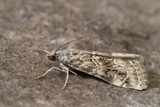Hellula undalis (Fabricius, 1781) Species
Last modified: Nov. 20, 2025, 6:33 p.m.
A new species for Belgium in 2019 in AN.
Details
- Classification
- Family: Crambidae > Subfamily: Glaphyriinae > Tribus: Glaphyriini > Genus: Hellula > Species: Hellula undalis
- Vernacular names
- Verkennertje (NL), Old World Webworm (EN), La Nymphule ondée (FR), Südeuropäischer Kruziferenzünsler (DE)
- Status
-
Migrant
For your information, to the best of our knowledge, the first 10 Belgian observations are listed here:
1) 1 ex. on 01.viii.2019 at Muizen (AN), leg. G. Verbeylen.
2) 1 ex. on 24.x.2022 at Revogne (NA), leg. C. Steeman.
3) 1 ex. on 29.x.2022 at Uncimont (LX), leg. K. Arnouts.
4) 1 ex. on 30.x.2022 at Bunsbeek (VB), leg. P. Collaerts et. al.
5) 1 ex. on 18.ix.2023 at Kalmthout (AN), leg. G. Vermeersch et. al.
6) 1 ex. on 21.ix.2023 at Schoten (AN), leg. T. Vochten et. al.
7) 1 ex. on 27.ix.2023 at Mabompré (LX), leg. F. De Coster.
8) 1 ex. on 21.viii.2025 at Wenduine (WV), leg. G. Rappé.
9) 1 ex. on 28.viii.2025 at Lochristi (OV), leg. N. Geelen et al.
10) 1 ex. on 28.viii.2025 at Welden (OV), leg. T. Delva et al.
Distribution
Caterpillar
A pale greenish-brown colored larva with five broad, irregular reddish-brown bands that extend the length of the body. The head is very dark brown.
Bionomics
The caterpillars initially bore into the stem of growing shoots, later instars feeding in the leaves and leaf stems. The caterpillars make a web of silk around their feeding area which accumulates frass.
Pupation occurs within the silken shelter generally spun between leaves or at the entrance of the feeding tunnel. But they have also been found under or beside secondary buds growing from old cabbage stems, inside the stem and bases of dropped leaves, or approximately 1/8 inch deep in the soil immediately surrounding the host plant.
Adults live from 4 to 9 days depending on temperature.
The adults come to light.
Flight periods
Specimens have been seen in Belgium from early August towards late October.
Observed on
- Host plant (genera):
- Brassica
- Substrates:
- Cultivated crops
The caterpillars are an agricultural pest on crops in the Cabbage family (Brassicaceae), particularly.



